Abstract
Purpose
The purpose of this study was to compare the wear characteristics of human enamel opposing 2 heat-pressed ceramics (e.max Press and Empress Esthetic), conventional feldspathic porcelain (Ceramco 3) and type III gold alloy.
Material and methods
Intact cusps of extracted premolars were used for enamel specimens. Five disk samples were made for each of two heat-pressed ceramics groups, conventional feldspathic porcelain group and type III gold alloy group. Wear tests were conducted in distilled water using a pin-on-disk tribometer. The amount of enamel wear was determined by weighing the enamel specimens before and after wear tests, and the weight was converted to volumes by average density. The wear tracks were analyzed by scanning electron microscopy and surface profilometer to elucidate the wear characteristics.
Results
1. Ceramco 3 led to the greatest amount of enamel wear followed by Empress Esthetic, e.max Press and type III gold alloy. However, there was no significant difference between Ceramco 3 and Empress Esthetic (P > .05), and there were also no significant differences among Empress Esthetic, e.max Press and type III gold alloy (P > .05). 2. The average surface roughness of e.max Press after wear test was smallest followed by Empress Esthetic and Ceramco 3, but there was no significant difference between Empress Esthetic and Ceramco 3 (P > .05). 3. There were no significant differences among the depth of wear tracks of all the groups (P > .05). The group that showed the largest width of wear track was Ceramco 3 followed by Empress Esthetic, e.max Press and type III gold alloy. However, there was no significant difference between e.max Press and Empress Esthetic (P > .05), and there was also no significant difference between Empress Esthetic and Ceramco 3 (P > .05).
Go to : 
REFERENCES
1.Seghi RR., Rosenstiel SF., Bauer P. Abrasion of human enamel by different dental ceramics in vitro. J Dent Res. 1991. 70:221–5.

2.Kim SH., Lee JH., Kim YL., Dong JK. Fracture strength of the IPS empress crown: The effect of occlusal using depth and axial inclination on lower first molar. J Korean Acad Prosthodont. 2003. 41:48–60.
3.Yeo IS., Yang JH., Lee JB. In vitro marginal fit of three all-ceramic crown systems. J Prosthet Dent. 2003. 90:459–64.

4.Tidehag P., Gunne J. A 2-year clinical follow-up study of IPS Empress ceramic inlays. Int J Prosthodont. 1995. 8:456–60.
5.Sulaiman F., Chai J., Jameson LM., Wozniak WT. A comparison of the marginal fit of In-Ceram, IPS Empress, and Procera crowns. Int J Prosthodont. 1997. 10:478–84.
6.Rosenstiel SF., Land MF., Fujimoto J. Contemporary Fixed Prosthodontics,. 4th ed. Mosby, St. Louis MO;2006.
7.Isgro G., Pallav P., van der Zel JM., Feilzer AJ. The influence of the veneering porcelain and different surface treatments on the biaxial flexural strength of a heat-pressed ceramic. J Prosthet Dent. 2003. 90:465–73.
8.Kelly JR., Tesk JA., Sorensen JA. Failure of all-ceramic fixed partial dentures in vitro and in vivo: analysis and modeling. J Dent Res. 1995. 74:1253–8.

9.Liu YH., Feng HL., Bao YW., Qiu Y. Effect of core: dentin thickness ratio on the flexure strength of IPS Empress II heat-pressed all-ceramic restorative material. Beijing Da Xue Xue Bao. 2007. 39:64–6.
10.Wiley MG. Effects of porcelain on occluding surfaces of restored teeth. J Prosthet Dent. 1989. 61:133–7.

11.DeLong R., Sasik C., Pintado MR., Douglas WH. The wear of enamel when opposed by ceramic systems. Dent Mater. 1989. 5:266–71.

12.Mahalick JA., Knap FJ., Weiter EJ. Occlusal wear in prosthodontics. J Am Dent Assoc. 1971. 82:154–9.

13.Lambrechts P., Braem M., Vuylsteke-Wauters M., Vanherle G. Quantitative in vivo wear of human enamel. J Dent Res. 1989. 68:1752–4.

14.Jacobi R., Shillingburg HT Jr., Duncanson MG Jr. A comparison of the abrasiveness of six ceramic surfaces and gold. J Prosthet Dent. 1991. 66:303–9.

15.Jagger DC., Harrison A. An in vitro investigation into the wear effects of selected restorative materials on enamel. J Oral Rehabil. 1995. 22:275–81.

16.Clelland NL., Agarwala V., Knobloch LA., Seghi RR. Wear of enamel opposing low-fusing and conventional ceramic restorative materials. J Prosthodont. 2001. 10:8–15.

17.Eom SH., Oh SC., Dong JK. A study on the wear of dental restorative materials. J Korean Acad Prosthodont. 1998. 36:514–23.
18.Ramp MH., Suzuki S., Cox CF., Lacefield WR., Koth DL. Evaluation of wear: enamel opposing three ceramic materials and a gold alloy. J Prosthet Dent. 1997. 77:523–30.

19.McLaren EA., Giordano II RA., Pober R., Abozenada B. Material testing and layering techniques of a New two-phase all-glass veneering porcelain for bonded porcelain and high-alumina frameworks. Quintessence Dent Technol. 2003. 26:69–81.
20.Monasky GE., Taylor DF. Studies on the wear of porcelain, enamel, and gold. J Prosthet Dent. 1971. 25:299–306.

21.Krejci I., Krejci D., Lutz F. Clinical evaluation of a new pressed glass ceramic inlay material over 1.5 years. Quintessence Int. 1992. 23:181–6.
22.Graf H. Occlusal forces during function. In, Rowe NH, Occlusion: Research on form and function. University of Michigan: Ann Arbor;1975. p. 90–111.
23.Pintado MR., Anderson GC., DeLong R., Douglas WH. Variation in tooth wear in young adults over a two-year period. J Prosthet Dent. 1997. 77:313–20.

24.Oh WS., Delong R., Anusavice KJ. Factors affecting enamel and ceramic wear: a literature review. J Prosthet Dent. 2002. 87:451–9.

25.Drummond JL., King TJ., Bapna MS., Koperski RD. Mechanical property evaluation of pressable restorative ceramics. Dent Mater. 2000. 16:226–33.

26.Grossman DG. Structure and physical properties of Dicor/MGC glass-ceramic. Mormann WH, editor. International Symposium on Computer Restorations. Chicago: Quintessence;1991. p. 103–15.
Go to : 
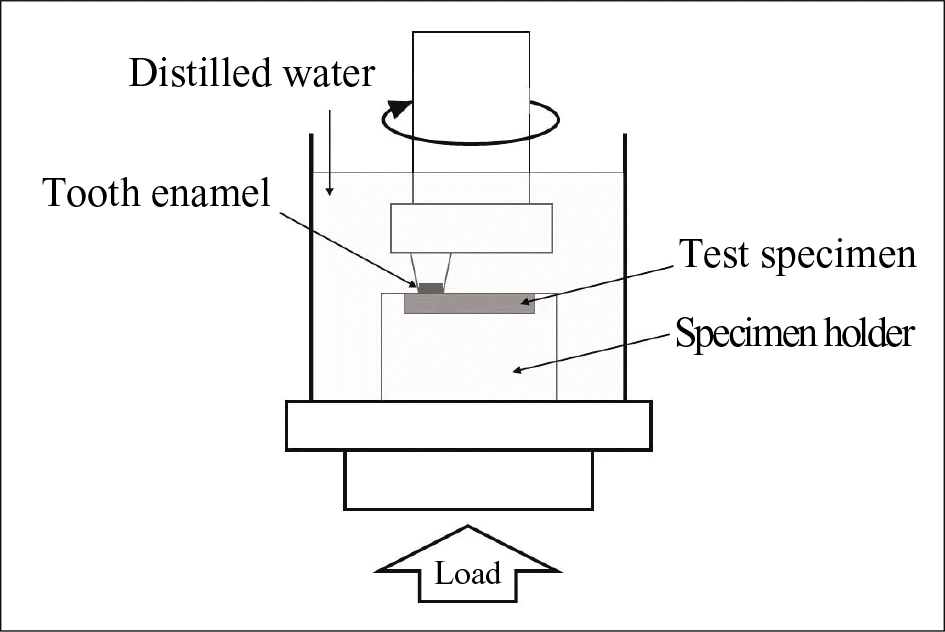 | Fig. 1.Schematic diagram of pin-on-disk tribometer with enamel and test specimen in wet environment. |
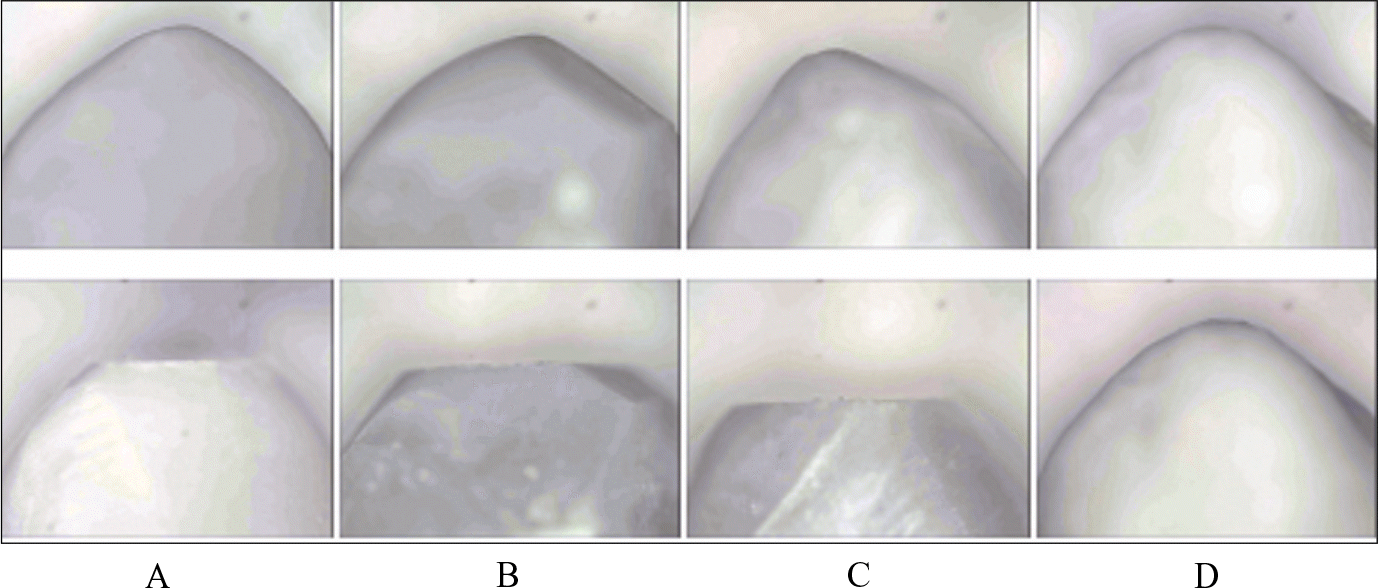 | Fig. 2.Optical microscopic images of enamel cusp tips before (upper) and after (lower) wear test, Original magnification × 5. A, opposing e.max Press; B, opposing Empress Esthetic; C, opposing Ceramco 3; D, opposing type III gold alloy. |
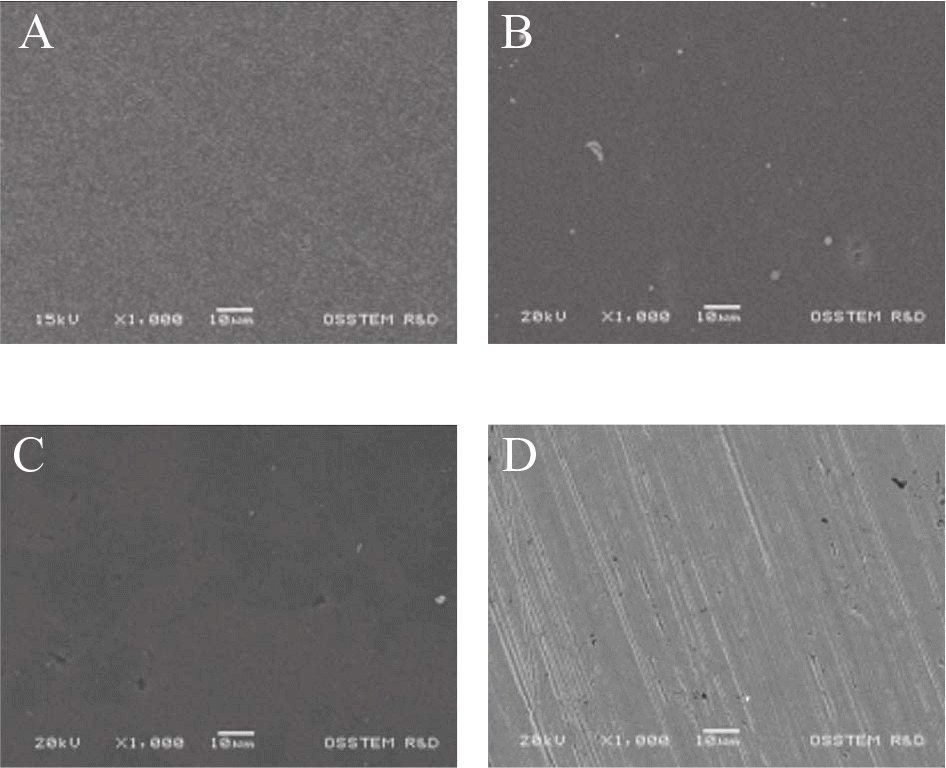 | Fig. 3.SEM photomicrographs before wear test, Original magnification × 1,000. A, e.max Press; B, Empress Esthetic; C, Ceramco 3; D, Type III gold alloy. |
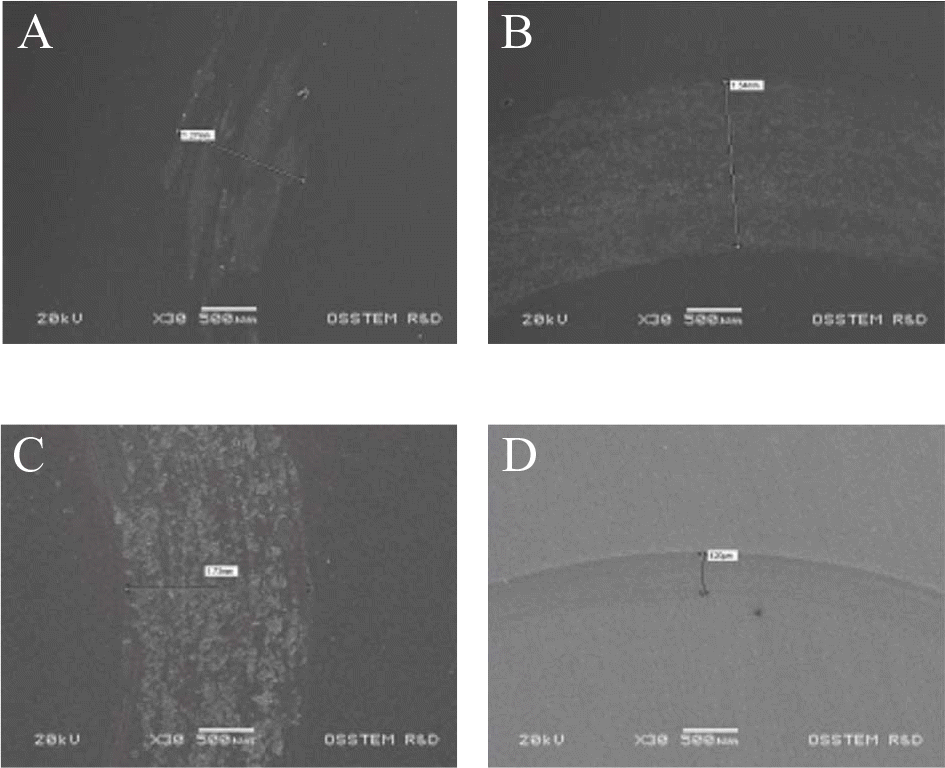 | Fig. 4.SEM photomicrographs after wear test, Original magnification × 30. A, e.max Press; B, Empress Esthetic; C, Ceramco 3; D, Type III gold alloy. |
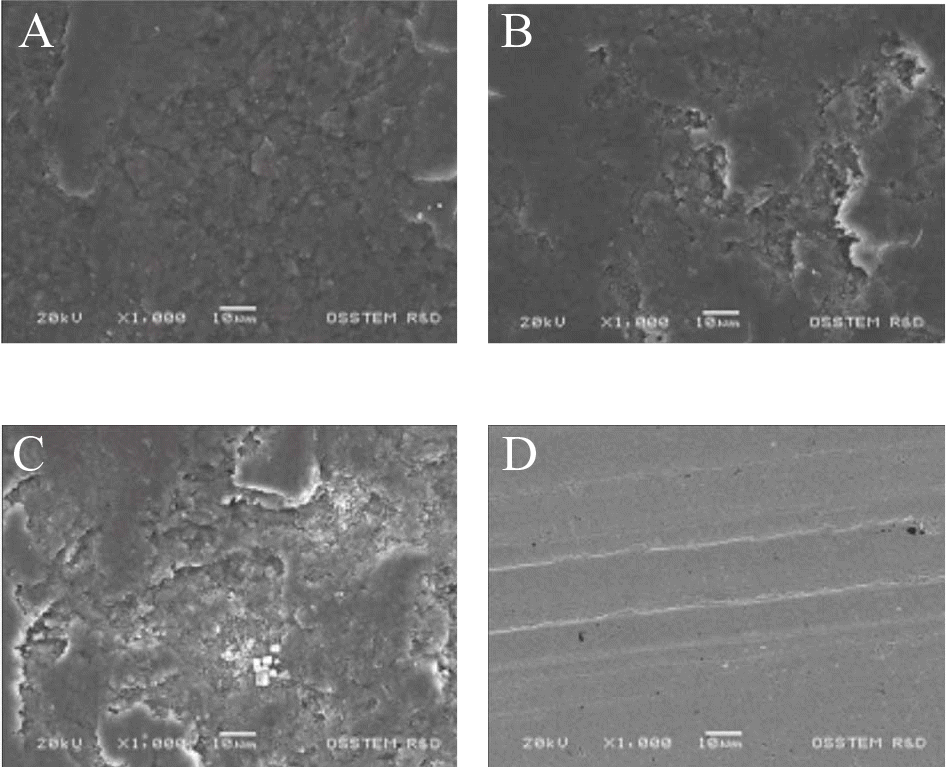 | Fig. 5.SEM photomicrographs after wear test, Original magnification × 1,000. A, e.max Press; B, Empress Esthetic; C, Ceramco 3; D, Type III gold alloy. |
Table I.
List of materials
Table II.
Mean values and SDs of wear volume of tooth enamel (mm3)
| Test material | Enamel wear volume |
|---|---|
| e.max Press | 0.61 ± 0.34a |
| Empress Esthetic | 1.21 ± 0.38ab |
| Ceramco 3 | 2.18 ± 1.30b |
| Type III gold alloy | 0.14 ± 0.06a |
Table III.
Mean values an mens before and after wear d SDs of surface rough r tests (㎛) ness of restorative
Table IV.
Mean values and SDs of wear track depth of restorative specimens (㎛)
| Test material | Wear track depth |
|---|---|
| e.max Press | 2.486 ± 0.683a |
| Empress Esthetic | 5.323 ± 1.075a |
| Ceramco 3 | 5.649 ± 1.037a |
| Type III gold alloy | 6.991 ± 5.454a |




 PDF
PDF ePub
ePub Citation
Citation Print
Print


 XML Download
XML Download